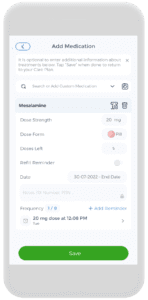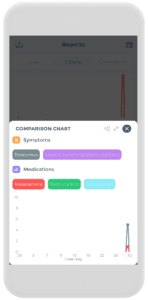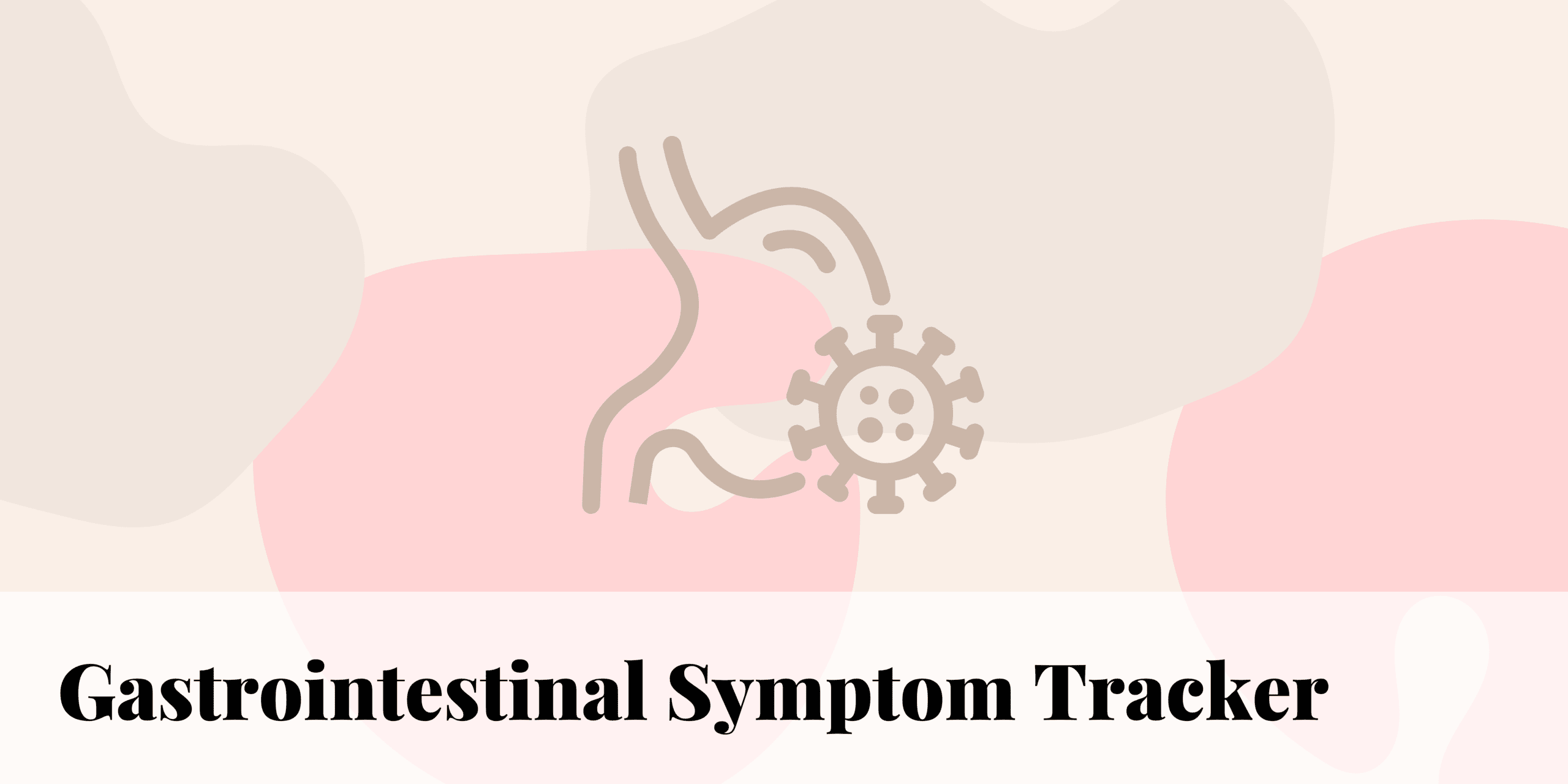After eating your last bite of what you swear is the most delicious cheesecake you have ever had, it travels through your body into the digestive system. Here, it is broken up into its separate nutrients and absorbed into your blood, muscles, and cells to nourish you as fuel for your body. Thus, the digestive system is vital for sustaining life. Part of the digestive system is your gastrointestinal (GI) tract. The GI tract is the heart of your digestion, without which your body would struggle to keep running. Fascinatingly, mental health correlations with worsening GI health have also helped uncover the emotional connection to the tract.
Moreover, not paying enough attention to your GI health can cause severe illnesses to your overall well-being. Luckily, GI monitors – such as a GI diary or the CareClinic GI Symptom Tracker – keep a record of your GI function to prevent serious health concerns.[1]
What is a GI Tract?
The gastrointestinal tract consists of many hollow organs linked together to form a winding tube leading from your mouth to your anus1. Hollow organs include the mouth, esophagus, stomach, small and large intestine, and anus1. Why are they called hollow organs? Well, think back to how these organs look and what they have in common. They all enclose a hollow space, hence their name!
What you may not already know about your GI tract is the bacteria it houses1. The 1,000 species of micro bacteria in your gut form a symbiotic relationship with, well, you2. They perform many functions that, while unclear, appear necessary for the health of your GI tract2. These bacteria are essential helpers in your digestion and are a huge part of maintaining a healthy and happy gut1. The disruption of your microbiome can result in an unbalance, potentially causing various diseases that significantly impact your health2.
The role of the gastrointestinal tract is a big one, starting from the moment you take a bite of food. Your mouth chews the food with the help of saliva to break it down before your tongue pushes your food down your throat and into your esophagus1. This is where the process becomes automatic, and something called peristalsis begins. Peristalsis is the name used to refer to the movement of the organ walls meant to help move foods and liquids through the GI tract. Think of this as pushing a freezie’s end on a hot summer day. When you squeeze the bottom, the freezie moves up since the plastic in front is still relaxed. Similarly, the muscle contraction behind the food pushes the food forward to the relaxed muscle in front1.
Lowering GI
Waste is a relatively ambiguous term for pretty much anything your body doesn’t need and/or want. This could include undigested food, old cells, excess fluids, etc1. Your lower GI targets these waste products and focuses on eliminating them as a stool. The main goal of the large intestine is to turn liquid waste into a solid by absorbing all water into its wall. From there, Peristalsis moves what remains (your … well, your poop) into the rectum. This is where the stool is stored until a bowel movement occurs1.
The Brain-Gut Connection with GI
One of the most interesting aspects of your GI tract has recently grown in popularity. If you’re anything like my TikTok ‘For You’ page and me, you may have comes across a variety of videos from many creators about how your gut plays a large part in your mental health. Correlations between anxiety, depression and ADHD with unhealthy bowel movements, food sensitivity and more. Well, turns out, there’s more merit to these claims than you may have thought.
Researchers have recently worked to uncover an emotional connection to the GI tract, a linkage that has now been dubbed the Brain-Gut connection. This connection runs between the emotional and cognitive centers of your brain and peripheral intestinal functions. Interestingly, the bidirectional interactions between the two are thought to be spearheaded but none other than your millions of friends living in your GI tract – the microbacteria. Signalling along this connection is done by means of neural, endocrine, immune, and hormonal links.
Unhealth Bowel Movements
To make this connection more understandable, let’s consider an example. Imagine you’re stomach begins to hurt randomly, and you seem unable to poop. You decide to take a look back to consider what you might have done to cause these symptoms but realize your routine is identical to how it has been your entire adult life. So what might have happened to cause your symptoms? The only thing that has really changed is your stress level. Perhaps you are moving home or are stuck on a problem at work. Regardless, you have been feeling stressed lately and wonder if this has any effect on your gut health.
The answer: yes! The enteric nervous system (ENS) – the system of nerves lining your GI tract – pick up on your anxiety and stress from signals in your brain. This, in turn, sends signals along the brain-gut link to your GI tract, reducing the motility (speed of food transit) of digested food and causing your constipation. Additionally, releasing cortisol – a major stress hormone – can signal to your gut through the ENS and cause abdominal pain. Let’s not forget that gut microbacteria can also influence your ENS neurons and many other cells, such as immune, epithelial and smooth muscle cells, to invoke similar consequences reciprocally. Considering the brain-gut connection help to uncover the emotional connection to the gut and GI tract as a whole.[2]
A Struggling GI Tract
I’ve repeatedly mentioned that gastrointestinal tract illnesses are … less than ideal. But what does this really encompass? Do they all have similar symptoms, or are they each completely different? How do I know I’m suffering from a gastrointestinal disease? If you’ve been wondering about any of these questions, you’ve come to the right place!

In essence, GI diseases can affect any part of the GI tract and are of 2 types: functional and structural. Functional diseases affect the functionality aspect of your GI health. While the tract may look healthy and normal, it does not move or function the way it should. Functional diseases are the most common disease and can be due to a variety of factors that we will touch on shortly. Contrarily, structural diseases are due to the deformation or abnormality of the shape of the large and small intestines upon examination. It is due to these abnormalities that the bowel does not function normally.
Recognizing a struggling GI tract can be difficult in your busy life. Using a symptom tracker, such as the CareClinic symptom tracker, can help you keep track of when symptoms begin and end. The convenience of keeping your healthcare maintenance in your pocket makes it easy for you to record symptoms as you experience them, making for a more accurate and helpful record when trying to diagnose a stubborn GI tract.[3][4]
Common Illnesses, Symptoms and Treatment for GI
Constipation
Constipation is generally known as the inability to, for lack of a better term, poop5. During constipation, it becomes difficult to have a bowel movement. The strain you may place on your organs and muscles while attempting a bowel movement can cause small, hard stools and in serious cases, anal problems such as hemorrhoids and fissures.
Treating constipation is relatively uncomplicated. Increasing fibre and water in your diet, regular exercise, and keeping track of your bowel movements are all good steps to overcoming constipation. While these remedies are more all-natural, laxatives can help speed things along but should always be taken with caution and in accordance to the product guidelines5.
Irritable Bowel Syndrome (IBS)
In this functional condition, your colon – a part of your large intestine – contracts either more or less than it should5. IBS has many triggers ranging from food and medication to stress and emotion5. Some symptoms of IBS include:
- For example, excess gas and bloating5
- Pain and cramping in the abdomen5
- Change in bowel habits5
- Such as constipation and diarrhea5
Treating IBS depends on your personal triggers. You may find that diet is your biggest cause, while your best friend might notice that stress sets off theirs. Each person is different, but as a guide, excessive caffeine or stress, a lack of fibre, dehydration and poor sleep can cause IBS. The opposite may help treat your symptoms5.
Hemorrhoids
A structural disease, hemorrhoids are swollen blood vessels that line your anal opening5. The excess pressure from a bowel movement, diarrhea or pregnancy can cause hemorrhoids to occur. Internal hemorrhoids are found within the anal opening. These hemorrhoids fall to the opening as a result of strain and may become irritated and begin to bleed. External hemorrhoids are found outside the anus and, after a particularly large amount of strain, can burst and pile under the skin5.
Treatment for internal hemorrhoids can be as simple as improving your bowel habits or asking your healthcare provider for ligating bands5. However, treatment for severe internal hemorrhoids or external hemorrhoids can be more invasive. Surgical removal is often the recommended course of action in these cases5.
Colitis – Ulcerative Colitis
Colitis is a broad term to describe a condition that causes inflammation of the bowel. Infectious colitis, Crohn’s disease and Ischemic colitis are all possible examples or colitis5. One type of colitis we will touch on is Ulcerative colitis, a disease that affects up to 7/100,000 people annually6.
Ulcerative colitis causes ulcers and irritation in the large intestine6. While the underlying cause of ulcerative colitis is unknown, the illness seems to present chronically and has significant morbidity6. Symptoms of ulcerative colitis include:
- For example, inflammation of the rectum extending to large intestine6
- For instance, rectal urgency and tenesmus (feeling like you need to poop) 6
- Intermittent bloody diarrhea6
- Cramping6
- Tiredness6
- Weight loss6
- Anemia6
- Nausea6
- Such as fever and skin rashes6

Treatment for ulcerative colitis often includes medication, starting with the go-to first-line treatment, mesalamine-containing therapies6. Oral steroid therapy, such as prednisone, can help to control symptoms if needed; however, it is not a long-term treatment. Intravenous corticosteroids are the third line of treatment, and intravenous cyclosporine is a forth6.
Keeping track of these medications and any others you have been taking to determine their effectiveness can be difficult. Luckily, CareClinic offers a medication tracker that makes it simple and straightforward. Along with dosage and time were taken, the notes feature allows you to write side effects and interactions you may be experiencing. The medication tracker makes it easier to figure out exactly what works best for you.
Colon cancer, anal fissures and fistulas, perianal infections and abscesses are all other illnesses you should be aware of and keep an eye out for. Thus, regular colon checks, especially for men at high risk, are essential to diagnosing these problems quickly and efficiently to ensure the most promising outcomes. Early detection is always the best way to keep yourself healthy and happy.[5]
Identifying your Triggers
Knowing exactly what causes your gastrointestinal disease to flare up can be vital to leading a normal and happy lifestyle. For many, including myself, abdominal pain, discomfort, and the whole host of other symptoms that accompany these disorders can make it impossible to go about your day, virtually destroying your quality of life. Identifying triggers and risk factors that are individualized to you is the key to living with these diseases, especially if they are chronic.
Genetics
Gastrointestinal syndromes cluster in families, indicating a strong genetic component to the disorders7. While there’s not much that you can do to ‘treat’ this, recognizing a family history of GI or lower GI disease can help you to stay proactive. Regular checkups, diligent monitoring and adjusting your diet and hydration can all help you stay safe and healthy in the face of GI disease.
Diet and Hydration
Diet and hydration play a large role in the onset of gastrointestinal disease7. Maybe you have a food intolerance that makes it difficult to digest a certain food, leading to an upset stomach and the beginning of a GI disease. High-fat meals, food chemicals and caffeine also seem to induce symptoms at the beginning of GI diseases7. Whatever the scenario, a food and hydration tracker can help you keep your diet aligned with what works best for you. Additionally, it can help you identify troubling foods and diets that cause unhealthy bowel movements in your lower GI, along with more general pain and discomfort associated with GI syndromes.
FODMAP
One specific diet that appears successful in randomized control trials of gastrointestinal disorders, such as IBS, is FODMAP7. FODMAP stands for Fermentable Oligo-, Di-, Mono-saccharides and Polyols, specific types of sugar that are significantly reduced in the diet. Low levels of these sugars reduce symptoms and make GI illnesses more manageable7. Furthermore, guidelines for the FODMAP diet are easily accessible online. Accordingly, the diet is easy to start with the help of food and nutrition trackers, such as the CareClinic app.
We have already discussed the strong association between psychological disorders and gastrointestinal disorders, so it makes sense that stress, anxiety and depression act as significant triggers7. High levels of psychological distress do correlate with GI symptoms. Often, certain GI disorders, such as constipation, appear as symptoms of psychological disorders and are an integral part of the disease experience7. It is important to recognize that your mind and body are influenced by each other, and so to take care of one is to take care of the other. The brain-gut connection is proof of this fact and an example to remember when dealing with GI disorders.
Gastrointestinal Symptom Tracker
These are only three broad triggers or risk factors from a list of many. No matter what your triggers may be, it is important to be able to identify them in a timely and efficient manner to get your health back on track quickly. So, what is the best way to identify your triggers?
Diagnosis and treatment begin with looking at the clues a syndrome presents. These clues are your symptoms. A gastrointestinal symptom tracker is an amazing resource to use and is both straightforward and accessible in the digital age. These trackers can be specialized for certain problem areas, such as an acute lower GI symptom tracker, or may be individualized towards your triggers, like a diet and GI symptom tracker app. Nevertheless, a GI monitor or even a piece of paper that serves as a GI diary is a great way to identify your personal triggers and stay ahead of GI illness.[6][7][8]
What makes a Good GI Symptom Tracker?
To figure out what exactly makes a good GI symptom tracker, let’s take an example presented by the European Cystic Fibrosis Society8. This tracker has all the hallmarks of an exemplary typical and functional tool and is currently even digitized for your use. Some features it includes are:
- For example, a record of the enzymes you may be taking for your digestion, along with the strength of the enzyme and dosage instructions8
- A weekly questionnaire related to appetite, bathroom patterns, bloating, diarrhea, cramping, stomach-ache or constipation, acid reflux, eating patterns and medication consistency8
- A series of questions targeted specifically toward diet and psychological symptoms, such as specific foods and embarrassment, taking medication or using a public restroom8
- Questions related to the quality of your bowel movements, including how often, gas, loose stool, and smell8
- In addition, a series of questions related to your lifestyle habits, including if you had enough time to eat, the effect of GI health on your school, work, or daily activities and how often you eat fast food8
Personalizing your Gastrointestinal Symptom Tracker
A good GI symptom tracker targets many different facets of GI health, including the psychological side, risk factors such as diet and medication and your personal habits8. This tracker is only one general example of a gastrointestinal symptom tracker. Interestingly, personalizing your tracker to best suit your needs may also be a considerable option. For example, perhaps you have more trouble with your acute lower GI tract and therefore, you can find or design your own acute lower GI symptom tracker. We already mentioned diet and GI symptom trackers that integrate both a possible cause and the consequences.
GI Tracker to Lower GI
The CareClinic app acts as a tracker in its entirety, uniquely setting it apart from traditional GI symptom trackers. Moreover, while most GI symptom trackers may be one page with limited questions that target a select few aspects of a select few disorders, the CareClinic app manages many different facets of your health to give you the big picture.

For example, CareClinic provides a symptom, sleep, nutrition, and fluid tracker to cover the physical manifestations of GI illnesses. The therapy and GI diary functions help you target your gut-brain connection as well. If you are in need of an acute lower GI symptom tracker or low GI diet tracker, combining the fluid, nutrition, and stool trackers is likely the best option to create an all-comprehensive record of your gut health.
Alternatively, if the diet is your main trigger, nutrition and the symptom tracker may create a diet and GI symptom tracker designed for you. Or maybe, for low GI diet trackers, perhaps you only want the stool function to track your lower GI function.
The correlations and charts feature under the reports tab make it easy to view trackers together and observe patterns between each aspect of your gut health. Overall, the CareClinic app acts as an individualized GI monitor you have the power to design for YOU.
References
- National Institute of Diabetes and Digestive and Kidneys Diseases. (2017). Your Digestive System & How it Works. Digestive Diseases. Retrieved from: https://www.niddk.nih.gov/health-information/digestive-diseases/digestive-system-how-it-works
- Brenchley, J. M., & Douek, D. C. (2012). Microbial Translocation Across the GI Tract. Annual Review of Immunology, 30, 149-173. https://doi.org/10.1146/annurev-immunol-020711-075001
- Carabotti, M., Scirocco, A., Maselli, M. A., & Severi, C. (2015). The gut-brain axis: interactions between enteric microbiota, central and enteric nervous systems. Annals of Gastroenterology, 28(2), 203-209. https://www.ncbi.nlm.nih.gov/pmc/articles/PMC4367209/
- Harley, J. (2019). Anxiety and Constipation – Can Stress Cause Constipation?. Mindset Health. Retrieved from: https://www.mindsethealth.com/matter/anxiety-and-constipation
- Cleveland Clinic. (2021, January 14). Gastrointestinal Diseases. Retrieved from: https://my.clevelandclinic.org/health/articles/7040-gastrointestinal-diseases
- Langan, R. C., Gotsch, P. B., Krafcyzk, M. A., & Skillinge, D. D. (2007). Ulcerative Colitis: Diagnosis and Treatment. American Family Physician, 79(9), 1323-1330. https://www.proquest.com/docview/234241372
- Talley, N. J. (2020). What Causes Functional Gastrointestinal Disorders? A Proposed Disease Model. The American Journal of Gastroenterology, 115(1), 41-48. https://doi.org/10.14309/ajg.0000000000000485
- European Cystic Fibrosis Society. (2017). GI Symptom Tracker. Retrieved from: https://www.ecfs.eu/sites/default/files/general-content-files/working-groups/Mental%20Health/GI%20Symptom%20Tracker-Final.pdf
References
- “The gut-brain connection – Harvard Health”. https://www.health.harvard.edu/diseases-and-conditions/the-gut-brain-connection
- “Here's Everything You Need to Know About Gut Health”. https://time.com/5556071/gut-health-diet/
- “Putting Functional Gastrointestinal Disorders within the Spectrum of Inflammatory Disorders Can Improve Classification and Diagnostics of These Disorders – PMC”. https://pmc.ncbi.nlm.nih.gov/articles/PMC10967747/
- “Symptom Tracker App | GI Monitor, Symptom Diary & IBS App | MyGiHealth”. https://mygi.health/app
- “Why Does Everyone Seem to Have IBS Now?”. https://time.com/7020813/do-i-have-ibs/
- “Pharmacogenetics and the treatment of functional gastrointestinal disorders – PMC”. https://pmc.ncbi.nlm.nih.gov/articles/PMC5591464/
- “Efficacy of a low-FODMAP diet in adult irritable bowel syndrome: a systematic review and meta-analysis – PMC”. https://pmc.ncbi.nlm.nih.gov/articles/PMC8354978/
- “Functional gastrointestinal disorder”. https://en.wikipedia.org/wiki/Functional_gastrointestinal_disorder



